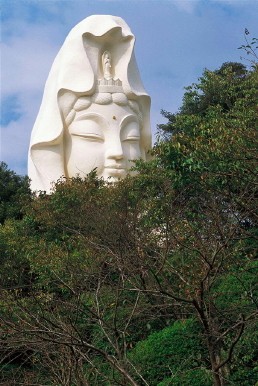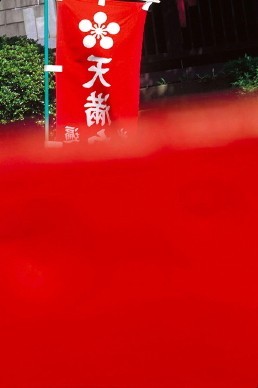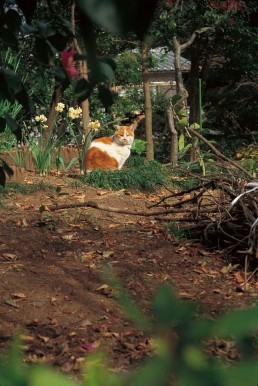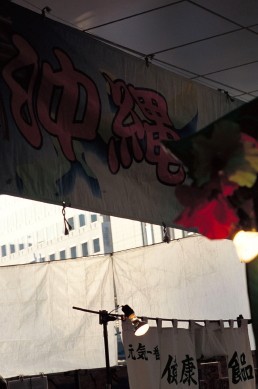Naked Photography II: Takuma Nakahira’s ‘Kirikae’
In my previous column, based on the fact that in his recent solo exhibitions at BLD Gallery and ShugoArts Takuma Nakahira had abandoned the presentation method of showing photographs in pairs, I wrote the following:
Nakahira’s latest solo exhibitions at BLD Gallery and ShugoArts consisted of photographs taken between 2002 and 2010, and the biggest change over this period is the disappearance of the presentation method of showing photographs in pairs. As a result, the absorptive mode of Nakahira’s work has taken over, and the craziness of the photographs is even more exposed. With this style as the constant and two compulsive images of “a tactile surface layer” and “a single eye (a shot of a single subject captured center frame, open to interpretation as a metaphor for the ‘camera’s eye’)” as the variable (on this occasion), the sensibility of Takuma Nakahira the individual is doing nothing more than relating to the photograph. As if the artist himself is on the verge of being sporadically swallowed up by pure photographs (the equivalence of “this”) that have lost all sense of distance and become more and more intense. Only the “name” series is tenuously connected to the artist’s biographical life, while the small number of “photographs with landscape falling off the edge of the frame (to the extent that the landscape in the background that is visible beside the central ‘this’ is also captured, these are photographs not of ‘this’ but of ‘this also’)” narrowly escape the crazy power of Nakahira’s photographs. These solo shows were a terrifying tug of war.
However, when I viewed the same collection of photographs displayed differently at Nakahira’s “Kirikae” exhibition at Comme des Garçons Six in Osaka’s Shinsaibashi, I noticed a shift from the human-centric viewpoint that I referred to as the “craziness of the photographs” and realized that there existed as if there had been all along a different dimension to these “photographs” themselves. The truth of the “terrifying tug of war” is that, just as there was a change in Nakahira’s photographs in the mid 1970s (1974-76) that preceded a change in Nakahira the critic (the 1977 memory loss), now his photographs have begun to change again and Nakahira the person is in the process of being pulled along by these changes.


Left: The background is bright, and the main bamboo shoot overlaps the bamboo behind (see penguins; “Documentary” 2005). Right: Bamboo shoot from “Nakahira Takuma: Degree Zero – Yokohama” (2002). The bamboo shoot stands out clearly against a dark ground.
It is true that the essence of photography is that every being becomes “this,” and in this thisness, or haecceity, everything becomes equivalent. “That! This! What I have alienated here is a kind of photographic conclusion for the time being!” (Takuma Nakahira in 2004) However, even if everything is equivalent in this thisness, because humans are the ones that indicate “this,” this essence is nothing but the craziness of photographs as seen from the viewpoint of humans. Another essence of the photographs as photographs selected by Takuma Nakahira in 2011 is that they do not have a center in the form of “that” or “this.” In these photographs, everything is reproduced equivalently. To put it another way, every point on the surface of the photograph is “this,” and the photograph captures “this and that.” “Scenery that passes by” best represents the change in Nakahira. I didn’t realize it in Tokyo, but this change is in fact across the board, finding expression in almost all of the photographs. From photographs in which Nakahira zooms in on his subject using a telephoto lens and makes a single, brightly colored object (“this”) present itself against a dark background – what one might call “photographs of concentration” – to photographs in which blur beyond the focal length, extraneous elements in front of the lens or miscellaneous scenery (“this and that”) captured beside or behind the original subject occupy so much of the surface of the photograph that they cannot be ignored – what one might call “photographs of distraction” – Nakahira is transitioning from photographs of “this” to photographs of “this and that.”


Foreground (left, “Documentary” 2008) and blur (right, “Documentary” 2007) transform into the subject of the photo.
Incidentally, the obvious reality that photographs capture equivalently everything in front of the lens regardless of whether or not people try to become absorbed in a particular thing applies to all photographs, and of course to all of Nakahira’s photographs to date. In this sense, rather than the photographs having changed, we should perhaps say that Nakahira’s outlook on photography is in the process of changing. The fact that he is no longer obsessed with showing photographs in pairs, the shift in his absorptive mode and the emphasis on “this and that”-ness have all combined to shape this transformation.


Left: Out-of-focus foreground and cat (“Documentary” 2004). Right: Characters and mixed background (“Documentary” 2005).
As I explained previously, by forming pairs of absorptive photographs, the presentation method of showing Nakahira’s photographs in pairs served as an expression of “absorption” itself. When this disappeared, it seemed as if the distance the photographer had kept between himself and his photographs also disappeared, and so when I wrote, “the absorptive mode of Nakahira’s work has taken over, and the craziness of the photographs is even more exposed,” I was being one-sided. This is because the pairs of photographs have not disappeared; rather, they have been combined into single photographs. In the fashion world, the word used in the Japanese title of this exhibition, kirikae, is used when the fabric on a garment is replaced with another kind of fabric (such as in a shirt where a different fabric is used from the chest up), and in this exact same sense Nakahira’s photographs are kirikae photographs. The method of combining absorptive subjects and a presentation method that epitomizes “absorption” have been unified in single photographs that combine the dual elements of absorptive subject (“this”) and blurred extraneous and border elements around or in front of this (“this and that”). Here are some typical examples:

“That” penguin and “this” penguin (“Documentary” 2006).
In the sense that they narrow down the focus and close in on absorptive subjects such as animals and sleeping people, Nakahira’s photographs are as always immersive, but instead of counteracting this immersion by pairing each of these photographs with another, here Nakahira uses compositions that emphasize another kind of equivalence of the photographs. Elements such as duplication and blurring, foreground and border are examples of kirikae within a single photograph. In other words, the Japanese title of this exhibition indicates a new stage in Nakahira’s photography, a dual condition in which the photographs are at once photographs of “this” and photographs of “this and that.” Could this be a shift from photography as pure as possible when viewed from the human perspective (“This! That!” *1) to truly pure photography? We will need to keep a close eye on Nakahira’s future work to find out.
Takuma Nakahira’s “Kirikae” is on display at Comme des Garçons Six, Osaka, through May 29.
All images ©2011 Takuma Nakahira. Courtesy of Osiris.
-
“It [the photograph] says: that, there it is, lo! but says nothing else.” Roland Barthes, Camera Lucida: Reflections on Photography, trans. Richard Howard, p.5.
Archive
Critical Fieldwork: Observations on Contemporary Art in Japan 1-6
